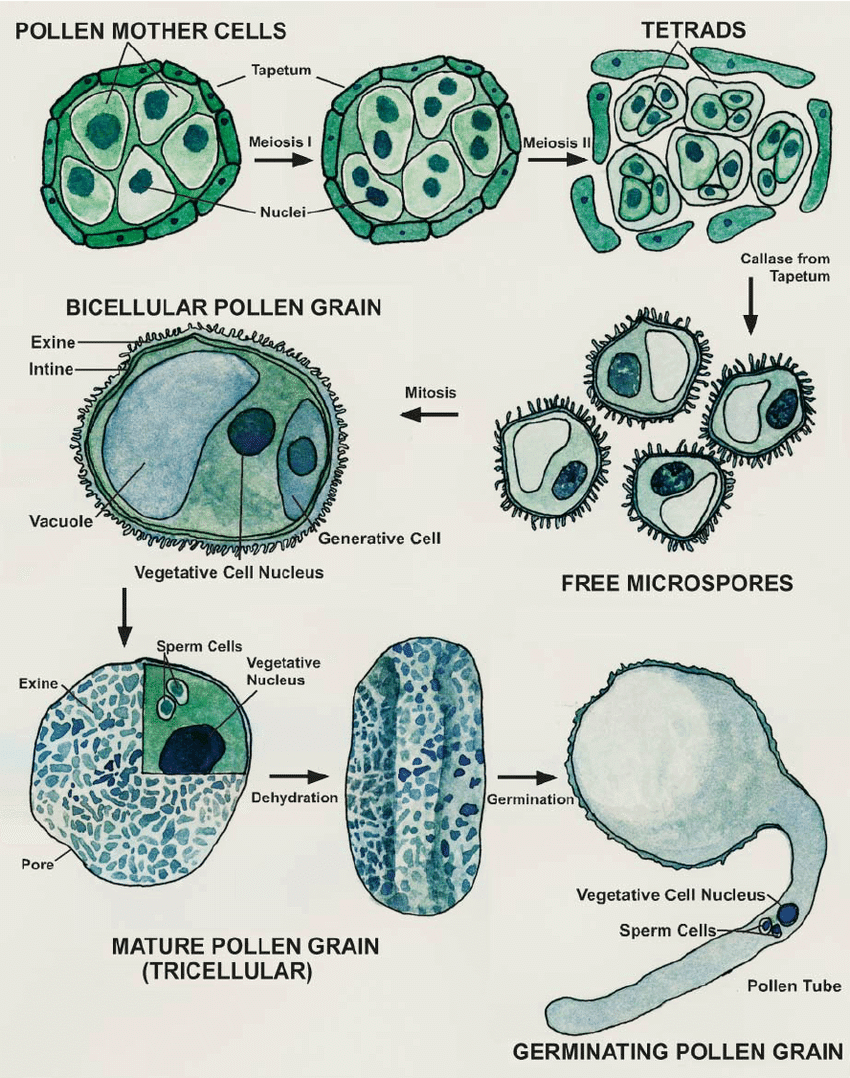Microsporogenesis | Biology for Grade 12 PDF Download
| 1 Crore+ students have signed up on EduRev. Have you? Download the App |
Microsporogenesis
- The anther appears as an outgrowth like structure in the initial stage which shows spherical or oval-shaped structure.
- At this stage, it is a mass of undifferentiated and homogenous meristematic cells which is surrounded by a single cell thick outer layer. This layer is known as the epidermis.
 Scheme of Microsporogenesis
Scheme of Microsporogenesis - First of all vascular tissue are formed in the middle region. Simultaneously a group of cells located just below the epidermis in vertical rows in the region of hypodermis at the four corners become large has a visible nucleus with dense cytoplasm. Due to this reason, they are different from the rest of the cells. These cells are called archesporial cells.
- These cells divide periclinally to form primary parietal cells below the epidermis and primary sporogenous cells towards the centre. Both of the cells usually undergo further divisions to form a complete structure of anther except the epidermis.
- Primary parietal cells undergo further periclinal and anticlinal division to form a series of 3-5 layers making the walls of the anther.

- Out of them outermost layer of the anther is formed just below the epidermis by primary parietal cells is called endothecium or fibrous layer. The endothecium is followed by 1-3 celled thick layer is termed middle layer. The innermost layer of the anther which surrounds pollen sacs is called tapetum. Later the tapetal cells play a significant role during the meiotic cell division in microsporogenous cells and in pollen development.
- The primary sporogenous cells divide twice or more than two by mitotic division to form sporogenous cells and later sporogenous differentiated into microspore mother cells during the formation of wall of pollen sac.
- Each microspore mother cell divides to form four haploid microspore or pollen grain by meiotic division or reduction division.
- During this period spherical bodies are formed inside the tapetal cells before their disintegration. These spherical bodies are known as Ubisch-body. Ubisch body is made up of a complex substance called sporopollenin. It is the polymer of carotenoids.
- After the formation of ubisch body, the tapetum layer degenerates. Ubisch bodies participate in the formation of exine of the microspores inside the pollen sacs. Now thick-walled microspores are called pollen grains.
- At the initial stage, all four microspores are attached together with the help of the callose layer. This group of microspores is called tetrad. After some time, this callose layer dissolves by callase enzyme. Which is secreted by tapetum.
Note:
- Normally each microspore mother cell can form tetrad by meiotic division. But in some plant like Zostera, some microspore mother cells become sterile and provide nutrition to rest of microspore mother cells.
- Similarly, tapetum is not well developed in Gentianaceae family so some cells of sporogenous tissue become sterile and provide nutrition to remaining sporogenous cells.
Old NCERT Syllabus
➢ Types of Tetrads
The arrangement of the microspores in tetrad condition as follows: Different types of Microspores
Different types of Microspores
(i) Tetrahedral tetrad: Four haploid microspores arranged in tetrahedral form.
Example: Dicotyledons - (Capsella). Tetrahedral Tetrad(ii) Isobilateral tetrad: This condition is found in monocotyledons. Microspores are arranged at the lateral side of each other.
Tetrahedral Tetrad(ii) Isobilateral tetrad: This condition is found in monocotyledons. Microspores are arranged at the lateral side of each other.
(iii) Decussate Tetrad: In this, two microspores lies at the right angle of other microspores.
Example: Magnolia
(iv) T-Shaped tetrad: Two microspores lie longitudinally and two microspores lie transversely in this type of tetrad. Example: Aristolochia & Butomopsis.
(v) Linear tetrad: In this tetrad, all four pollens arranged in linear order. e.g., Halophylla, Halophia.
All the above type of tetrads are found in Aristolochia elegans.
The most common type of tetrads is Tetrahedral.
Concept-Based Questions
Q.1. Explain the role of the tapetum in the formation of the pollen-grain wall.
Ans. Tapetum is the innermost wall layer of a microsporangium. It nourishes the developing pollen grains and also helps in the formation of the wall of pollen grains. The cells of tapetum secrete Ubisch granules that provide sporopollenin and other materials for exine formation.
Q.2. Where is sporopollenin present in plants? State its significance with reference to its chemical nature.
Ans. Sporopollenin is present in the exine of pollen grains in plants. It is one of the most resistant organic substances and can withstand high temperatures, strong acids and alkalis. It protects the pollen grains from enzymes and helps them to be well preserved.
|
124 videos|210 docs|207 tests
|
FAQs on Microsporogenesis - Biology for Grade 12
| 1. What is microsporogenesis? |  |
| 2. How does microsporogenesis occur? |  |
| 3. What is the significance of microsporogenesis? |  |
| 4. What is the role of microsporogenesis in plant breeding? |  |
| 5. How does environmental factors affect microsporogenesis? |  |

|
Explore Courses for Grade 12 exam
|

|





















